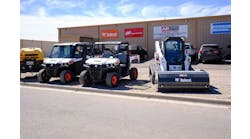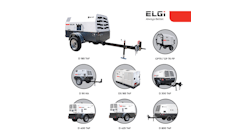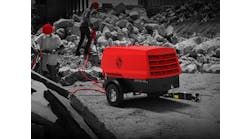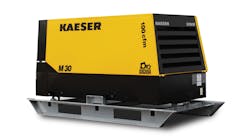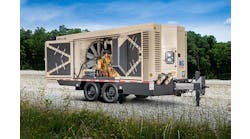Injury rates caused by musculoskeletal problems have skyrocketed in recent years. While interest in ergonomics has grown, much of the attention has been directed toward office and industrial workers.
Less research has been directed toward construction workers' back problems. But times are changing, and studies have been done concerning back problems resulting from concrete finishing and reinforcement, drywall work, electrical work, excavation and foundation work, form work, interior work, masonry, plumbing, roofing, sheet metal work, spraying, fireproofing and structural steel work.
Concrete demolition and removal poses some of the greatest challenges to users and manufacturers of pneumatic percussion hand tools. The most obvious problem is the weight of the tools. A small contractor might have a 90-pound breaker on the job for random breakout work. To a large construction worker, lifting and repositioning the tool with each breakout might not be a big burden. But to a smaller worker, it might be a major load, creating the possibility of a back injury.
So sizing the tool to the worker is extremely important. If a worker uses a chipping hammer where a paving breaker should be used, he or she would have to bend over in a way that could cause injury. In reverse, using a paving breaker for overhead work creates other problems. The tool should be sized to the worker and the job.
Hand and arm vibration is another issue. Repetitive motion of pneumatic tools without proper vibration isolation is associated with a disease known as white finger, or Raynaud's phenomenon. Dr. Maurice Raynaud first described it in 1861.
Dr. Alice Hamilton published one of the first reports in the United States on spastic anemia in stonecutters in 1918. Today many forms of ergonomic/vibration-dampened tools are available. Tools are designed with flexible handles, specially designed valves and orifices that limit airflow to the tool. Different materials also are being incorporated, such as special high-impact plastics and rubber. Smaller tools that hit hard with less weight are being developed.
So how should contractors protect workers using existing tools? A few remedies will reduce vibration. Most important is proper air pressure to the tool. So many times I have been on jobs and heard: “Higher pressure means more production!” It might be true with sandblasters moving blast media to clean a surface and might be partly true with tools such as impact wrenches.
However, high pressure in percussion tools causes the automatic valve to cycle improperly, resulting in an insufficient air cushion on the up and down strokes of the tool. This results in forces that destroy the tool and transmit shock to the operator. The manufacturer sees the results in a significant increase in warranty claims for internal parts in addition to steel retainer parts. The manufacturer wasn't there to see that the pressure regulator was turned up!
A possible solution would be sealed pressure settings at the factory, ensuring the compressor always maintains the same pressure. That, however, would eliminate the freedom to use the compressor in other applications. This is where the responsibility lies with the operator, who might seek to transfer liability to the rental center that rented the tool.
Ideally, the user should read the owner's manual from the manufacturer and adhere to its guidelines, and the rental center should provide this information. Generally, 85-90 pounds per square inch gauge at the respective cubic feet per minute of air requirement at the tool is all that is required. Proper air pressure is one of the most important elements in reducing vibration. It also saves fuel and wear and tear on the compressor.
Lubrication is another often overlooked issue. A properly lubricated tool is more efficient because less vibration causes less friction. Proper lubrication seals, cools and lubricates the tool, enhancing its performance and ability to cushion. Rock-drill oil is the ideal lubricant for pneumatic percussion construction tools.
Flexible handles
Flexible handles are great options if applied properly. Shock-isolated handles provide relief from some of the tool's recoil. Most paving breakers cycle from 900 to 1,500 blows per minute. A chipping hammer can cycle from 1,800 to 2,550 bpm. Before you rent a tool, make sure it has the right design for the job.
The key is to “test-drive” the tool and make sure it fits the user. A simple rubber flexible handle might actually transmit more shock than a conventional tool. Further, some flex-handle designs pivot so much that it takes extra movement to lift the tool to another spot. The key is making sure the handle fits.
If you have standard tools in stock, some manufacturers offer retrofit kits to convert those tools to flex-handle tools. Ergonomic gloves are also a sound, inexpensive investment.
Many companies gladly will pay more to rent or purchase ergonomic tools. The safety manager of a major utility company recently told me of two claims that were costing her company $250,000 and could have been avoided with ergonomically advanced tools. The extra cost might save your customer hundreds of thousands of dollars.
Noise transmitted from the tool is another important issue. A compressor must meet the federal guidelines of 76 decibels at 7 meters. To comprehend this measurement, if you have a digital stereo system, turn it down to 76 decibels, and you'll hardly hear the music. Compressors today are very quiet. But the tools are not. Muffled tools can reduce noise up to 6 decibels. However, a lot of the noise is generated from the piston's hitting the tool steel. A simple solution to this problem is ear protection.
Never overlook proper safety equipment. You can serve your customers well by providing eye protection, hard hats, safety shoes, gloves, dust protection and ear protection. Reading all of the manufacturers' safety guidelines will minimize the possibility of injury on the job.
In a perfect world, an operator would sit in a sound-insulated booth and operate a tool requiring minimal movement. But in the real world, time and space considerations necessitate the use of hand-held tools. The key is giving the operator the best possible tool and safest work environment.
Rasnack is manager of new business development for Sullivan-Palatek, Michigan City, Ind.
Sullivan-Palatek
Sullivan-Palatek's SCH-Series chippers are available in 2-, 3- and 4-inch stroke combinations for use in medium- to heavy-duty chipping, cutting and trimming. Features include an inside trigger, a throttle mechanism with a noncorrosive ball design, an oval collar retainer and spring, and a rotatable rubber muffler designed to direct exhaust away from the operator. Standard chuck sizes range from .680 round to .580 hex.
www.sullivanind.com
800/334-5022
Sullair
Sullair air tools include paving breakers, chipping hammers, rock drills, utility drills, rivet busters, clay and trench diggers, backfill tampers and needle and weld flux scalers. The company also offers breaker steel, rock drill and chipping hammer bits, hoses and accessories. The tools are designed with fewer wear parts and feature components that reduce air consumption, the company says.
www.sullair.com
800/SULLAIR [785-5247]
Atlas Copco
The Tex 419 is a four-bolt chipping hammer designed for chipping, chiseling and light demolition work. The hammer's high-airflow design, 4-inch piston, reliable plate valve and vibration-reducing ergonomic handle maximize productivity, according to Atlas Copco. The unit is available with hex or round bushing and standard or ball retainers.
www.atlascopco.com/cto
800/274-1464
Pioneer
Pioneer Tool & Forge manufactures its boom-mounted tools with its Ultra Grade steel, a high-strength alloy resistant to wear, according to the manufacturer. Pioneer makes tools for most popular breakers.
www.breakersteel.com
800/359-6408
Harper Air Tool
Harper Air Tool's 4102 rock drill is designed for speed drills with half-inch to 1 ½-inch diameters and a standard 7/8-inch to 3 ¼-inch shank. The 12-pound unit features right-hand rotation.
800/428-2652
General Equipment
General Equipment designed its MDF35 Long Reach air tool for a variety of applications, including the removal of floor tile, mastics, adhesives, concrete and stripping buildups. Equipped with a 60-inch whip hose and an internal valving mechanism, this tool requires a flow rate of 11 cubic feet per minute at 90 pounds per square inch and produces 3,100 blows per minute.
www.generalequip.com
800/533-0524
Brunner & Lay
Brunner & Lay offers more than 500 pneumatic tools and accessories, including points, chisels, narrow chisels and bladed tools for jackhammers as well as rivet busters, chipping hammers and boom-mounted demolition tools. All are made of steel alloys and forged, machined and heat-treated by Brunner.
www.brunnerlay.com
501/756-0880
Edco
Edco's Big Stick chisel scaler can remove materials such as quarry tile, multilayered vinyl tile or industrial floor buildups from concrete surfaces. Requiring 12 to 15 cubic feet per minute of compressed air at 90 pounds per square inch, the unit is ergonomically shaped for operator use in upright positions. Various accessories are available.
www.edcoinc.com
800/638-3326
American Pneumatic Tool
Airgo-line 138A and 155A rock drills feature APT's double-action vibration isolators, utilizing the Polysorb elastomer, which absorbs the upward and downward vibrations to the operator's hands and arms. The Airgo-line handle is interchangeable with APT standard models 138 and 155.
www.apt-tools.com
800/532-7402
